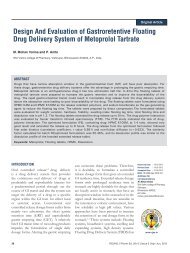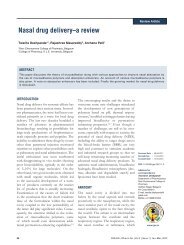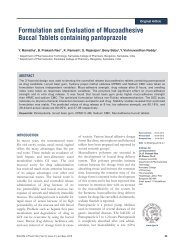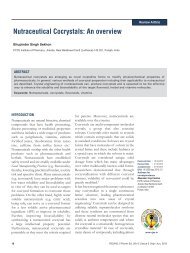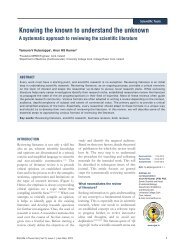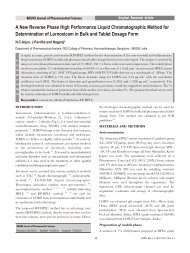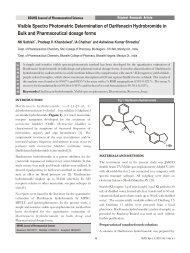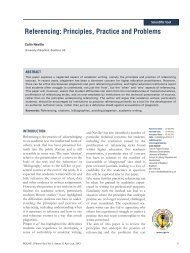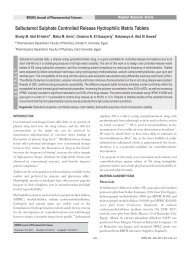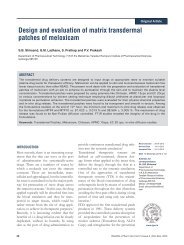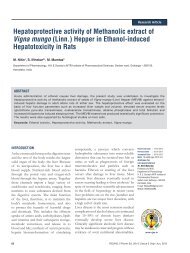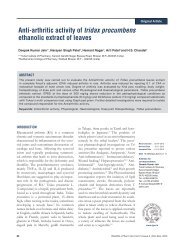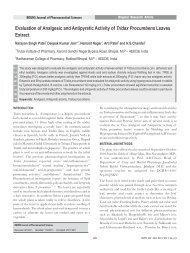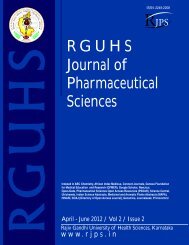Chitosan Loaded Mucoadhesive Microspheres of Gliclazide - Journal
Chitosan Loaded Mucoadhesive Microspheres of Gliclazide - Journal
Chitosan Loaded Mucoadhesive Microspheres of Gliclazide - Journal
Create successful ePaper yourself
Turn your PDF publications into a flip-book with our unique Google optimized e-Paper software.
RGUHS <strong>Journal</strong> <strong>of</strong> Pharmaceutical Sciences<br />
A Study on Drug-Drug Interaction <strong>of</strong> Diltiazem with Nateglinide in Diabetic<br />
Animals<br />
A B S T R A C T<br />
Raza Hasan*, Suresh D.K, Hamza Sheth, Md. Saifuddin Khalid and Mohiuddin M<br />
Luqman College <strong>of</strong> Pharmacy, Old jewargi road, Gulbarga-585102, Karnataka, India<br />
INTRODUCTION<br />
Drug interaction is a chemical or physiological reaction that<br />
can occur when two different drugs are taken together. It can<br />
occur when the effects <strong>of</strong> one drug are modified by the prior<br />
or concurrent administration <strong>of</strong> another drug. A drug<br />
interaction may result in beneficial or harmful effects.<br />
However, harmful effects are usually predominated. In<br />
considering the clinical relevance <strong>of</strong> pharmacokinetic drugdrug<br />
interactions mediated by drug-metabolizing enzymes,<br />
efficacy linked to dosage requirements and/or toxicity can be<br />
considered as appropriate endpoints. It may modify the<br />
1<br />
diagnostic, preventive or therapeutic activity <strong>of</strong> either drug .<br />
In multiple drug therapy, it is important to determine the<br />
incidence and frequency <strong>of</strong> occurrence <strong>of</strong> drug interactions,<br />
in hospitalized patients. Further, it is also useful to find out<br />
2<br />
agents that are most likely to produce hazardous interactions .<br />
A study which was conducted on drug-drug interactions in<br />
selected community pharmacies in which out <strong>of</strong> 1368<br />
prescriptions evaluated over a span <strong>of</strong> 3 months, 613<br />
interactions were found in 516 prescriptions, out <strong>of</strong> which<br />
16.15% interactions were severe, 3.75% interactions were<br />
found where patient was receiving more than 8 drugs and<br />
3<br />
11.58% interactions had a significance level . Almost 783,936<br />
people in the United States die every year from conventional<br />
4<br />
medicine mistakes .<br />
RGUHS <strong>Journal</strong> <strong>of</strong> Pharmaceutical Sciences<br />
Received: 2/2/2011, Modified: 21/2/2011, Accepted: 27/2/2011<br />
123<br />
Original Research Article<br />
Aim <strong>of</strong> this investigation was to study the drug-drug interaction between antidiabetic drugs and antianginal drugs. Interaction <strong>of</strong><br />
Nateglinide, the known Meglitinide antidiabetic drugs with Diltiazem (antianginal drug) was evaluated in normal healthy and STZ induced<br />
diabetic rats. The blood samples were collected from normal healthy and diabetic rats at different time interval upto 24 hrs and blood<br />
glucose was estimated. Diltiazem pre-treatment (15 mg/kg for seven days), has not significantly altered the onset <strong>of</strong> antidiabetic effect <strong>of</strong><br />
Nateglinide in healthy and STZ induced diabetic rats but significantly increased the peak antidiabetic effect from 40.80±2.54 %<br />
th<br />
reductions before treatment to 51.9±61.14% reduction after treatment at 6 hr and 46.16±1.25% reduction before treatment to<br />
th<br />
55.80±0.30% reduction after treatment at 6 hr in both healthy and in diabetic rats respectively. Duration <strong>of</strong> antidiabetic effect was<br />
enhanced from 08hrs to more than 18hrs in both groups. This study indicates that therapeutic drug monitoring is required, and the<br />
therapeutic dose <strong>of</strong> Diltiazem and Nateglinide, needs to be altered when used concomitantly.<br />
Keywords: Diltiazem, Nateglinide, STZ (Streptozotocin), Antidiabetic activity.<br />
Diabetes mellitus is a chronic metabolic disorder<br />
characterized by hyperglycemia, glycosuria, Hyperlipidemia,<br />
5<br />
negative nitrogen balance and sometimes ketonaemia .<br />
Diabetes is always coinciding with serious complications and<br />
adverse effects. Microvascular and macrovascular disease<br />
account for most <strong>of</strong> the morbidity and mortality associated<br />
with diabetes. Nearly 80% <strong>of</strong> deaths in those with type 2<br />
diabetes involve cardiovascular disease, Angina Pectoris or<br />
6<br />
stroke . Diabetic patients are more prone serious<br />
complications, like cardiovascular diseases, hypertension,<br />
arrhythmia, angina pectoris, and fungal infections etc which<br />
7<br />
require long term treatment . The total cost <strong>of</strong> diabetes to the<br />
US health care system in 2002 was estimated at $132 billion,<br />
the majority <strong>of</strong> this associated with the treatment <strong>of</strong> chronic<br />
8<br />
diabetic complications . In such cases multiple drug therapy is<br />
needed to prescribe. So, there is always a need for co -<br />
administration <strong>of</strong> calcium channel blockers like verapamil,<br />
nifedipine, amlodipine and diltiazem etc along with oral<br />
Antidiabetic agents like Nateglinide or Pioglitazone.<br />
There are reports that Nateglinide is predominantly<br />
eliminated by metabolism via the cytochrome P-450 enzyme<br />
9<br />
3A4 and CYP2C9 . Diltiazem is also metabolized by<br />
Cytochrome P-450 enzyme 3A4 and 2C9 and 2D6 and is<br />
10<br />
known to inhibit Cytochrome P-450 enzyme system , hence<br />
there is a possibility <strong>of</strong> occurrence <strong>of</strong> pharmacokinetic type <strong>of</strong><br />
drug interactions with concomitantly used drugs. Therefore<br />
the present study was carried out on healthy and diabetic rats<br />
to assess the influence <strong>of</strong> Diltiazem pretreatment on the<br />
antidiabetic effects <strong>of</strong> Nateglinide.<br />
RJPS, Jul - Sep, 2011/ Vol 1/ Issue 2



